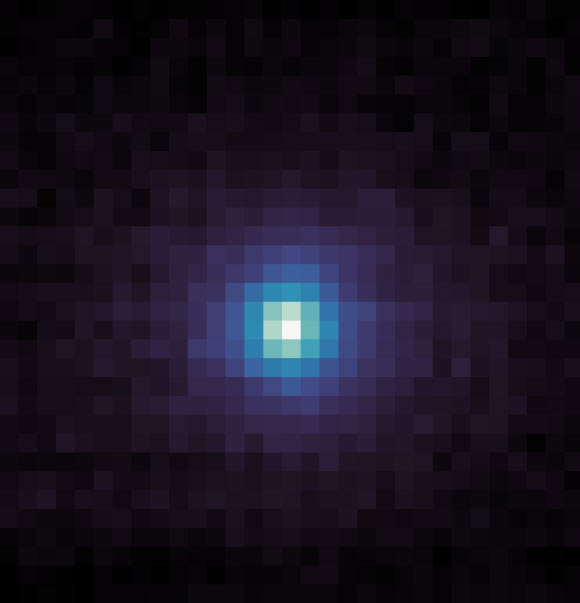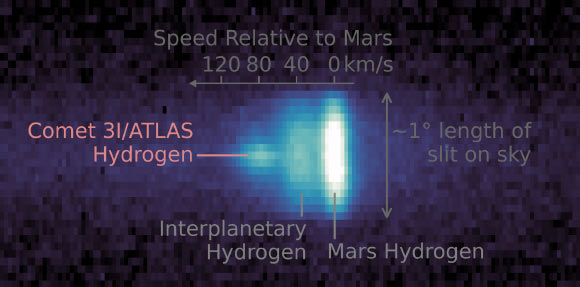The new ultraviolet (UV) images from the Imaging Ultraviolet Spectrograph (IUVS) camera aboard NASA’s MAVEN (Mars Atmosphere and Volatile EvolutioN) orbiter are unique among all observations of the interstellar comet 3I/ATLAS in determining its chemical makeup and how much water vapor is released as the Sun warms the comet. These details will help scientists better understand the past, present, and future of 3I/ATLAS.

This ultraviolet image shows the coma of 3I/ATLAS as seen on October 9, 2025, by NASA’s MAVEN spacecraft using its IUVS camera. The brightest pixel at center indicates where the comet is. The surrounding bright pixels show where hydrogen atoms were detected coming from the comet. Image credit: NASA / Goddard / LASP / CU Boulder.
Over the course of 10 days starting September 27, 2025, MAVEN captured 3I/ATLAS in two unique ways with its IUVS camera.
First, IUVS took multiple images of the comet in several wavelengths, much like using various filters on a camera.
Then it snapped high-resolution UV images to identify the hydrogen coming from 3I/ATLAS.
Studying a combination of these images, scientists can identify a variety of molecules and better understand the comet’s composition.
“The images MAVEN captured truly are incredible,” said MAVEN’s principal investigator Dr. Shannon Curry, a researcher with
“The detections we are seeing are significant, and we have only scraped the surface of our analysis.”

This annotated composite image showing hydrogen atoms from three sources, including 3I/ATLAS (at left), was captured September 28, 2025, by NASA’s MAVEN orbiter using its IUVS camera. Hydrogen emitted by Mars is the bright streak at right, with interplanetary hydrogen flowing through the Solar System indicated by the dimmer streak in the middle. Image credit: NASA / Goddard / LASP / CU Boulder.
The IUVS data also offer an estimated upper limit of the comet’s ratio of deuterium to regular hydrogen, a tracer of the comet’s origin and evolution.
When the comet was at its closest to Mars, Dr. Curry and colleagues used more sensitive channels of IUVS to map different atoms and molecules in the comet’s coma, such as hydrogen and hydroxyl.
Further study of the comet’s chemical makeup could reveal more about its origins and evolution.
“There was a lot of adrenaline when we saw what we’d captured,” said MAVEN’s deputy principal investigator Dr. Justin Deighan, also from the Laboratory for Atmospheric and Space Physics at the University of Colorado Boulder.
“Every measurement we make of this comet helps to open up a new understanding of interstellar objects.”







![The image shows NGC 1866 superimposed with a false color image from the MUSE data cube, where the ionized shell of the planetary nebula Ka LMC 1 is seen as a red ring. The grayscale insets illustrate the different size of the ionized shells of singly ionized nitrogen [N II] and doubly ionized oxygen [O III]. The magnified Hubble image near the center of the ring reveals the presence of a pale blue star -- most probably the hot central star of Ka LMC 1. Image credit: AIP / M.M. Roth / NASA / ESA / Hubble.](https://cdn.sci.news/images/2025/11/image_14348-Ka-LMC-1-104x75.jpg)